
Cilgerran is both a village, a parish, and also a community, situated on the south bank of the River Teifi in Pembrokeshire, Wales. It was formerly an incorporated market town.
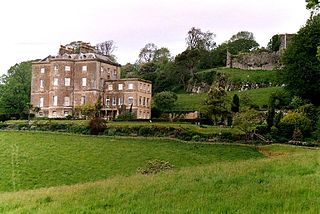
Penrice Castle is a 13th-century castle near Penrice, Swansea on the Gower Peninsula, Wales. Nearby is a neo-classical mansion house built in the 1770s. The mansion is a Grade I listed building, and the surrounding gardens and park is also listed at Grade I on the Cadw/ICOMOS Register of Parks and Gardens of Special Historic Interest in Wales.

Margam Castle, Margam, Port Talbot, Wales, is a late Georgian country house built for Christopher Rice Mansel Talbot. Designed by Thomas Hopper, the castle was constructed in a Tudor Revival style over a five-year period, from 1830 to 1835. The site had been occupied for some 4,000 years. A Grade I listed building, the castle is now in the care of Neath Port Talbot County Borough Council. The castle stands within Margam Country Park, the former estate to the house. The park is listed at Grade I on the Cadw/ICOMOS Register of Parks and Gardens of Special Historic Interest in Wales.

Margam Country Park is a country park estate in Wales, of around 850 acres (3.4 km2). It is situated in Margam, about 2 miles (3 km) from Port Talbot in south Wales. It was once owned by the Mansel Talbot family and is now owned and administered by the local council, Neath Port Talbot County Borough Council. Situated within the park are three notable buildings: Margam Abbey, a Cistercian monastery; Margam Castle, a neo-Gothic country house that was once the seat of the Mansel Talbot family; and the 18th-century Orangery. The park is designated Grade I on the Cadw/ICOMOS Register of Parks and Gardens of Special Historic Interest in Wales.

Llechryd is a rural village on the A484 road approximately 3 miles (4.8 km) from Cardigan, Ceredigion, Wales. Situated on the north bank of the tidal River Teifi, Llechryd is the first point upstream of Cardigan where crossing is possible. Most of the village has developed along the A484, with some estates branching off into the valley.
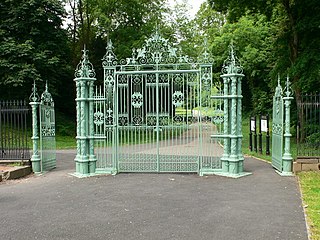
Pontypool Park is a 150-acre (0.61 km2) park in Pontypool, Torfaen, Wales. The park was formerly the grounds of Pontypool House and was laid out in the closing years of the 17th century for John Hanbury, an ironmaster, who is closely associated with Japanware. The grounds were purchased by the local authority in 1920, while the estate house was leased, and later sold, to the Sisters of the Holy Ghost to become St. Alban's RC High School. The former stables now house the Torfaen Museum. The grounds contain a number of structures including a double ice house, the Folly Tower and the Shell Grotto. The park is entered through the Pontymoile Gates. The gates, the grotto and the stables are all Grade II* listed structures, while the former hall and the ice house are listed Grade II. The park itself is designated at Grade II* on the Cadw/ICOMOS Register of Parks and Gardens of Special Historic Interest in Wales.

Llanerchaeron, known as "Llanayron House" to its nineteenth-century occupants, is a grade I listed mansion on the River Aeron, designed and built in 1795 by John Nash for Major William Lewis as a model self-sufficient farm complex located near Ciliau Aeron, some 2+1⁄2 miles south-east of Aberaeron, Ceredigion, Wales. There is evidence that the house replaced an earlier mansion. A later owner, William Lewes, was the husband of Colonel Lewis's inheriting daughter.

(New) Hawarden Castle is a house in Hawarden, Flintshire, Wales. It was the estate of the former British prime minister William Gladstone, having previously belonged to the family of his wife, Catherine Glynne. Built in the mid-18th century, it was later enlarged and externally remodelled in the Gothic taste.
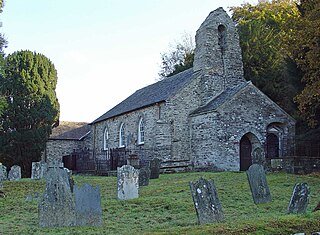
Manordeifi is a parish and community in the hundred of Cilgerran, in the northeast corner of Pembrokeshire, Wales. The population of the community in 2001 was 478. It has an elected community council and is part of the Cilgerran electoral ward for the purposes of elections to Pembrokeshire County Council.

Wynnstay is a country house within an important landscaped park 1.3 km south-east of Ruabon, near Wrexham, Wales. Wynnstay, previously Watstay, is a famous estate and the family seat of the Williams-Wynn baronets. The house was sold in 1948 and is under private ownership as of 2000.
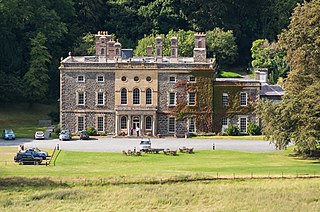
Nanteos is an 18th-century former country house in Llanbadarn-y-Creuddyn, near Aberystwyth, Ceredigion, Wales. A Grade I listed building, it is now a country house hotel. The gardens and parkland surrounding the mansion are listed on the Cadw/ICOMOS Register of Parks and Gardens of Special Historic Interest in Wales.
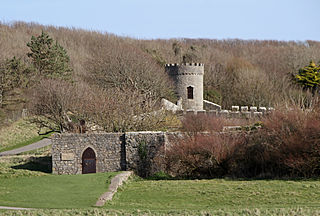
Dunraven Castle was a mansion on the South Wales coast near Southerndown. The existing manor house was rebuilt as a castellated hunting lodge in the early 19th century and was extensively remodelled later in the century. The surviving parts of the house are a Grade II listed building and its gardens and park are designated Grade II on the Cadw/ICOMOS Register of Parks and Gardens of Special Historic Interest in Wales.

Llanarth Court is a late-18th-century country house with substantial 19th-century alterations in Llanarth, Monmouthshire, Wales. The court was built for the Jones family of Treowen and was subsequently the home of Ivor Herbert, 1st Baron Treowen, whose family still owns much of the Llanarth estate, although not the court itself. The court is a Grade II* listed building and is now a private hospital. The gardens are included on the Cadw/ICOMOS Register of Parks and Gardens of Special Historic Interest in Wales.

Clytha Park, Clytha, Monmouthshire, is a 19th-century Neoclassical country house, "the finest early nineteenth century Greek Revival house in the county." The wider estate encompasses Monmouthshire's "two outstanding examples of late eighteenth century Gothic", the gates to the park and Clytha Castle. The owners were the Jones family, later Herbert, of Treowen and Llanarth Court. It is a Grade I listed building.

Itton Court, Itton, Devauden, Monmouthshire is a country house. The origin of the house was as an outstation for Chepstow Castle. In the 18th century, much of the medieval manor was pulled down and replaced. Further additions and alterations were made in the 19th and 20th centuries, including work by Guy Dawber. From the 18th until the mid-20th century, the court was the home of the Curre family, major landowners, who purchased the estate in 1749. It is a Grade II* listed building and its gardens are listed on the Cadw/ICOMOS Register of Parks and Gardens of Special Historic Interest in Wales.
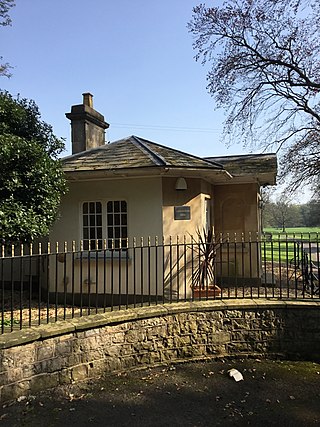
Wyelands, sometimes styled The Wyelands or Wyelands House, is a Grade II* listed building and estate located about 1 mile (1.6 km) north of the village of Mathern, Monmouthshire, Wales, United Kingdom and about 1 mile (1.6 km) west of the edge of Chepstow. It is a neoclassical villa designed by Robert Lugar in the late Regency period, and was completed around 1830. The park surrounding the house is listed on the Cadw/ICOMOS Register of Parks and Gardens of Special Historic Interest in Wales.

Llanerchydol is a hamlet in Powys, Wales, situated on the A458 about 2 km west of the centre of Welshpool. It is part of the community of Welshpool and also lends its name to an electoral ward of Welshpool Llanerchyddol.
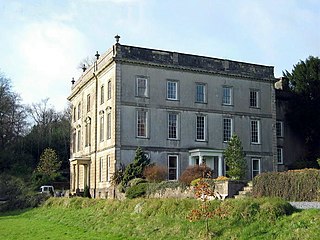
Plas Taliaris is a Grade I-listed building two miles to the north-east of Salem in Carmarthenshire, west Wales. It was first mentioned in 1336 and was owned by the Gwynne family until the house was sold in 1787. Most of the estate was sold in the 1950s and the house was restored in around 1989. Its gardens and park are registered on the Cadw/ICOMOS Register of Parks and Gardens of Special Historic Interest in Wales.
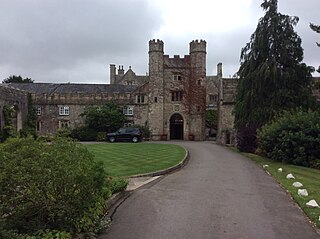
The Gatehouse and attached range, at the St Pierre Hotel, St Pierre, Mathern, Monmouthshire are the most significant remains of the mansion built by the Lewis family in the late 15th century and owned by them until 1924. The original house was built by William Lewis, and extended by his son George, between 1475 and 1508. After the Lewises sold up, the house had a variety of owners and was converted to the clubhouse of a golf club in 1962. It has since been massively extended as a hotel and country club. The gatehouse and range have Grade II* listed building status. The surrounding gardens are included on the Cadw/ICOMOS Register of Parks and Gardens of Special Historic Interest in Wales.

Pembrokeshire is a county in the south-west of Wales. It covers an area of 1,619 km2 (625 sq mi). In 2021 the population was approximately 123,700.





















